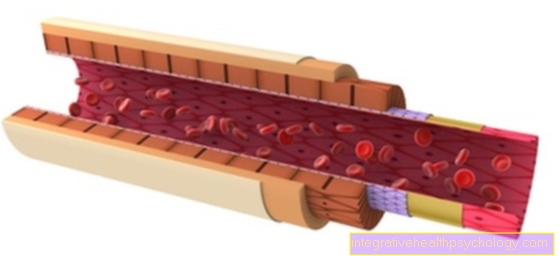Twinrix
definition
Twinrix® is a vaccine against the two infectious diseases hepatitis A and B.
As hepatitis is a liver inflammation that can be triggered by various viruses.
Hepatitis A is a form that is particularly common in subtropical and tropical regions, but still accounts for around a quarter of liver inflammation in Europe. It is transmitted faecal-orally, for example through contaminated water and / or food.

In children, hepatitis A infection is often symptom-free, and the fulminance of the course increases with age. Then you experience a fever, rash, jaundice, abdominal pain, nausea, vomiting and diarrhea. There is no chronic course of this disease.
In the case of hepatitis B infection, which is mainly transmitted through sexual intercourse or needle stick injuries, as well as through transmission from the mother to the unborn child, a distinction is made between an acute and a chronic course. The symptoms are similar to the description of a hepatitis A infection above. Chronic hepatitis B disease leads to cirrhosis of the liver in one fifth of cases.
Read more about this under
- Hepatitis A
- Hepatitis B.
Active ingredient
The vaccines contained in Twinrix® are dead vaccines. They therefore contain dead pathogens that are no longer capable of reproduction. In the case of the hepatitis A component one speaks of a whole-particle vaccine, i.e. whole parts of the dead virus are administered. The component of hepatitis B is a split vaccine, i.e. inactive particles of the pathogen are administered. These components trigger an immune response in the body, which is supposed to generate permanent protection. The active ingredient as a dead vaccine is usually very well tolerated and the components contained are not contagious.
Side effects
Since Twinrix® is a dead vaccine, it is generally better tolerated than live vaccines.
If side effects occur, they usually show up within 72 hours after vaccination. Headache, pain and redness at the puncture site or fatigue can occur very often, i.e. in one in 10 cases. Diarrhea, nausea or general malaise can occur in up to 1 in 10 cases. In addition, flu-like symptoms can occasionally occur, i.e. in up to 1 in 100 applications.
If the side effects persist for more than a few days and seriously affect the vaccinated person, a doctor should be consulted.
Read more on the topic: Vaccination side effects
How does vaccination with Twinrix work?
The vaccination is used in adolescents from the age of 16. The injection is made in the upper arm into the large deltoid, preferably on the side that is not used for writing. In other words, if the person is right-handed, the vaccination takes place in the left upper arm.
The potential puncture site is inspected to determine whether it is suitable. Then it is disinfected and the disinfection time is observed. The vaccinee also gently holds the deltoid muscle together and punctures it. The syringe is first pulled to check whether a blood vessel has not been hit. If this is not the case, you may inject. At the end, the puncture site is masked off with a plaster.
The vaccination should not be carried out if you have ever had an allergic reaction to Twinrix®, or an allergic reaction to other preparations that target hepatitis A or B. You should not be vaccinated if you are currently infected with a fever above 38 ° C.
Read more about this under
- Vaccination against hepatitis A
- Vaccination against hepatitis B
How often do you have to vaccinate?
Since the vaccination, as already mentioned, is a dead vaccine, a single vaccination is not sufficient for complete protection against the diseases. For this reason, vaccination three times over a period of 6 months has given a good result. Infection-free patients receive the first vaccination on an agreed date, the second one month later and the third and final vaccination 6 months after the first vaccination.
It is possible for adults to distribute the vaccination doses over just one month. However, this is only intended for people who need quick vaccination protection, such as long-distance travelers. Here the first vaccination takes place on the agreed date, the second after 7 days and the third on the 21st day after the first dose. With this vaccination scheme, a fourth vaccination is then recommended after 12 months.
When do you need to refresh?
The basic rule is that there is sufficient immunity to hepatitis A and B after 3 vaccination doses. However, it is possible at any time to determine a so-called titer for the respective immunization. Applied as a blood test, this then provides information about adequate protection. If, according to the definition, insufficient protection is guaranteed, the vaccinations should be refreshed. Hepatitis A protection, the recommendation of the Standing Vaccination Commission (STIKO), for 10 years.
Protection against hepatitis B is given for 15 years; there is currently no further vaccination recommendation after 15 years.
costs
The price of the respective vaccination dose of Twinrix® varies from around 60 to 80 euros, depending on the manufacturer. Thus, with a complete immunization with three vaccinations, the cost is around 180 to 240 euros.
Who pays the costs?
Not every cost bearer guarantees the assumption of the costs for Twinrix®, therefore, before the desired application, you should always ask the health insurance company whether they will cover the costs.
Most health insurance companies only recognize a need for vaccination for hepatitis B and then pay the costs. Due to the low likelihood of infection and the good hygienic standards of the western industrialized countries, hepatitis A is only seen as an optional vaccination for travelers to affected regions.
Are there any alternatives?
Alternatives for vaccination with Twinrix®, as a combination preparation, are the individual vaccinations for the respective hepatitis A and B immunization. After a previous hepatitis A infection, those affected are immune for life and do not need a vaccination, so if this is known, the doctor should be informed.





























